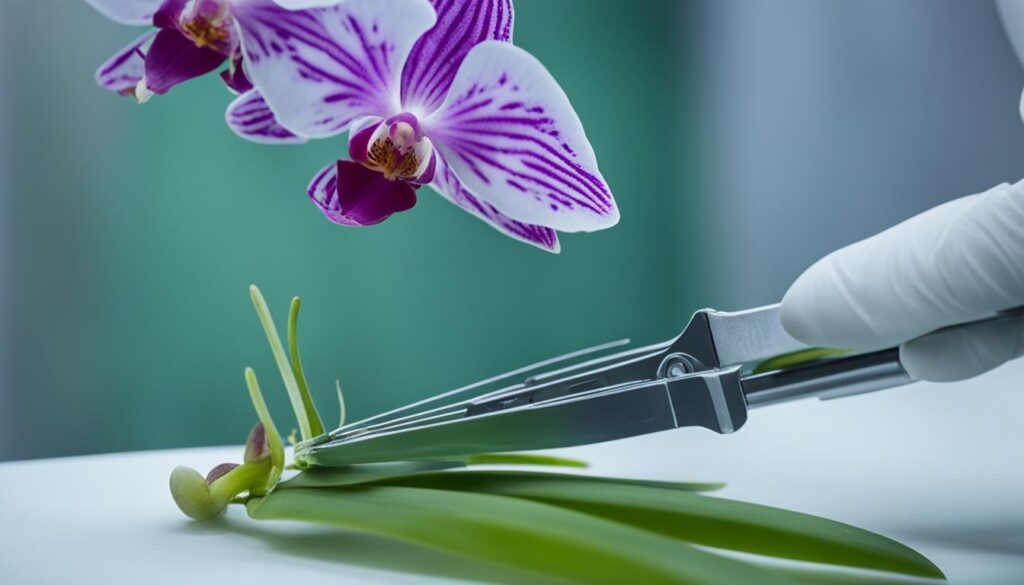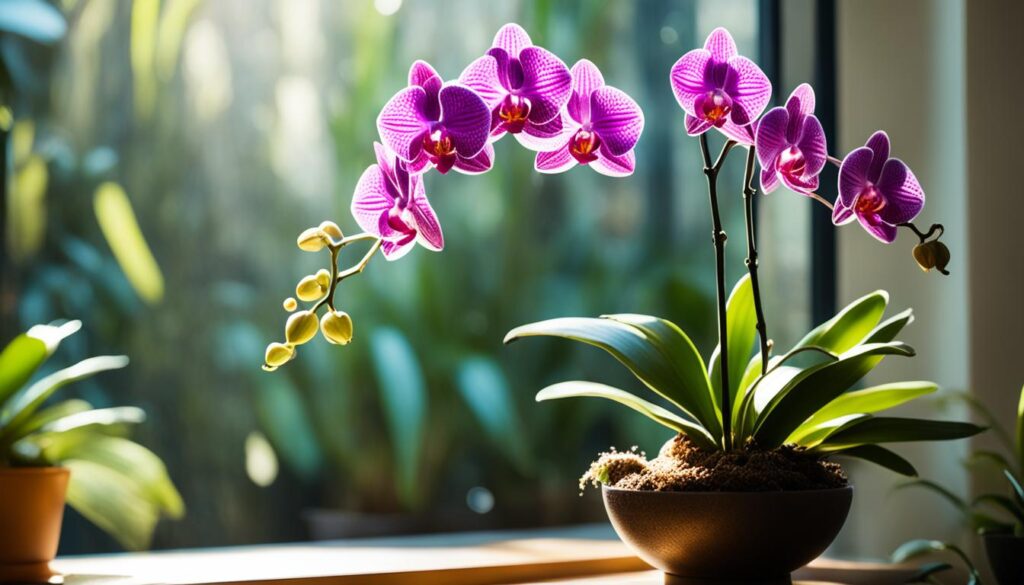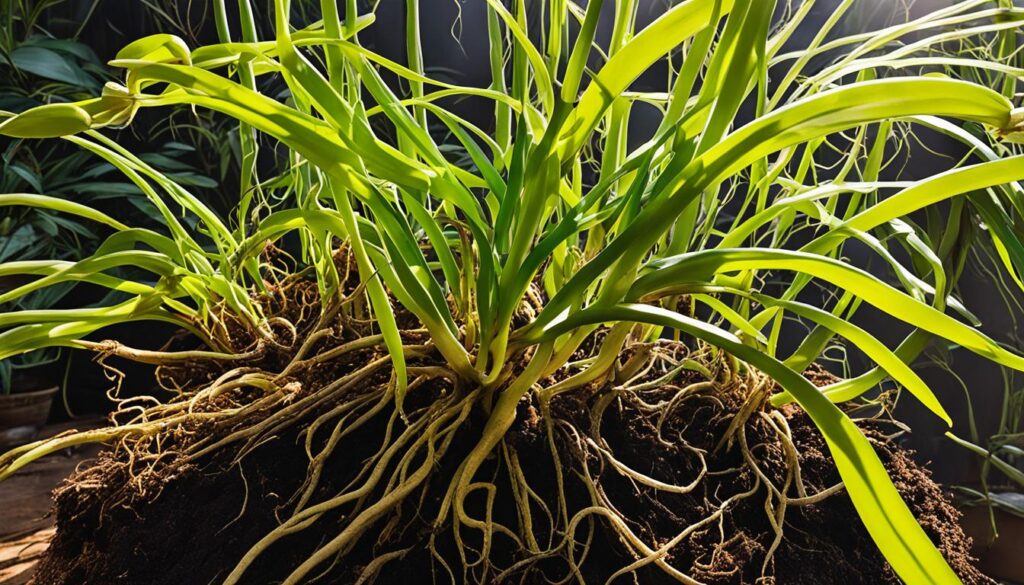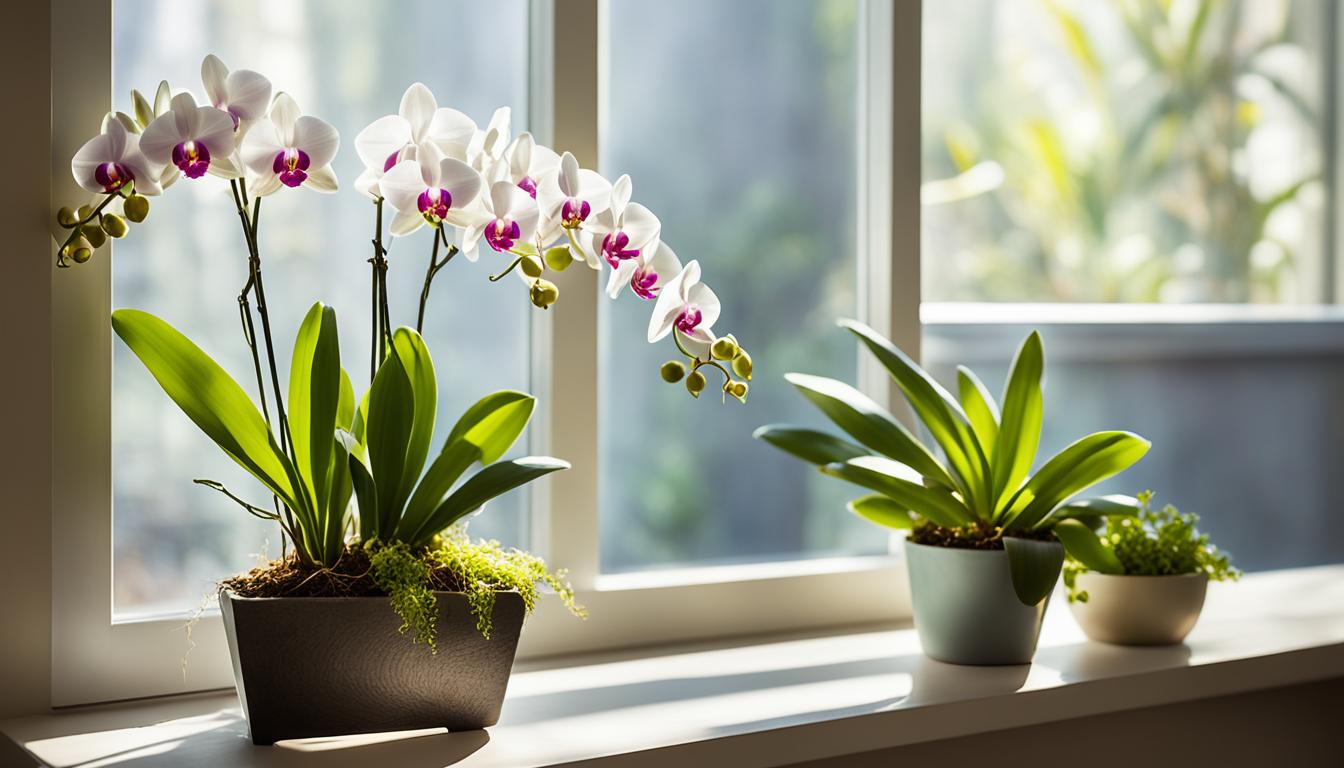For anyone passionate about orchids, ensuring the successful acclimatization of these stunning flowers is key to their vibrant display. Orchid acclimatization is the process by which these delicate plants adjust to their environment, enabling healthy orchid growth and vitality.
In my horticultural journey, I’ve witnessed orchids, with their array of colors and forms, transform spaces into tropical sanctuaries. The secret to thriving orchids lies in understanding their needs and meticulously catering to them, from the moment they arrive in our homes or gardens.
Let’s nurture our green thumbs by diving deep into effective orchid care tips and the fascinating world of these exotic beauties.
Key Takeaways
- Adequate orchid acclimatization is crucial for the transition into new environments.
- Implementing proven orchid care tips enhances the overall health and longevity of the plants.
- Maintaining specific conditions can foster healthy orchid growth, mirroring their native habitats.
- Attention to detail and patience are paramount to achieving thriving orchids.
- With the right guidance and practices, even novice gardeners can cultivate flourishing orchids.
- Regular observation and adjustments are necessary for adapting to the unique needs of each orchid.
Understanding Orchid Acclimatization and Its Importance
As someone with a profound interest in orchid cultivation, I’ve observed that the successful growth of these plants heavily relies on a well-executed process known as acclimatization.
This phase is not merely about introducing orchid species like Dendrophylax lindenii—also known as the Ghost Orchid, into a new space; it’s about ensuring their adaptation and subsequent ability to thrive in varying orchid environments.
Defining Orchid Acclimatization
Orchid acclimatization is fundamentally about the adjustment period plants undergo when they face new ambient conditions. They must adapt to shifts in critical environmental factors like light intensity, temperature ranges, and air quality to stabilize their growth and overall health.
My personal experiences underscore that the acclimatization period is a critical juncture in an orchid’s life cycle, whether it’s moving from a controlled environment into a different cultivation space, or being reintroduced to a natural habitat after propagation.
Why Acclimatization Matters for Orchid Growth
Acclimatization matters deeply for orchid growth because these plants are incredibly sensitive to environmental changes. A stabilized transition phase can ensure seamless adaptation, preventing the common stresses that often lead to plant morbidity or, worse, mortality.
This is particularly evident in delicate orchid variants, whose survival rates increase significantly when acclimatization is meticulously managed.
Emphasizing this step in the care of orchid species is a form of wisdom and dedication that pays dividends in the robustness and blooming patterns of these extraordinary plants.
The Role of Humidity and Air Movement in Orchid Acclimatization
The significance of humidity and air movement cannot be overstated in the context of orchid acclimatization. Orchids hailing from tropical regions are accustomed to high humidity and consistent air circulation.
Replicating these conditions is key to their successful adaptation. For instance, setting the right mist frequencies in a greenhouse mimics the natural moisture orchids would experience in the wild, easing them into their new orchid environment without overwhelming their systems.
Below is a table showing how various environmental settings affect orchid adaptation:
| Environmental Parameter | Impact on Orchid Adaptation | Optimal Condition for Acclimatization |
|---|---|---|
| Humidity | Crucial for hydration and nutrient uptake | 60%-80%, similar to tropical climates |
| Temperature | Affects metabolism and bloom cycles | Consistent day and night temperatures, avoiding extremes |
| Light | Drives photosynthesis and growth | Bright, indirect light, mimicking canopy shading |
| Air Movement | Prevents diseases, allows gas exchange | Gentle airflow, avoiding harsh drafts |
In my journey with orchid cultivation, the devotion to creating a conducive environment for acclimatization has been paramount.
It’s the bridge between a concealed potential and a fully actualized, splendid orchid display, intense with colors and vitality.
Orchid Propagation Techniques and Environmental Factors
As an enthusiast of orchid plants, I’ve found that successful orchid growth heavily depends on mastering the right propagation techniques paired with meticulous orchid maintenance.
Let me share with you some insights into both the scientific and the tender art behind propagating these exquisite plants.
Starting with the division of mature Phalaenopsis orchids, which is best done when they begin to crowd their pots, to nurturing keikis, each step involves a symphony of environmental conditions that must be finely tuned.

- Bright, indirect light that mimics the dappled sun of a forest canopy
- Stable room temperatures that don’t fluctuate wildly
- High humidity that creates a tropical-like atmosphere
Equally important are the hygiene practices. Suppose you’re not sterilizing your tools, or you’re neglecting the cleanliness of the growing area.
In that case, you’re opening up your precious orchids to a world of potential harm. That’s why I enforce a strict protocol on sterilization whenever I’m tending to my orchids.
Remember, propagation isn’t just a botanical routine; it’s a commitment to the continuation of life, a journey that takes both the plant and the grower through the cycles of growth and renewal.
| Propagation Method | Optimal Season | Key Environmental Considerations |
|---|---|---|
| Division of Mature Orchids | Spring | Ensuring ample space for new divisions to grow; maintain moderate moisture |
| Development of Keikis | Varies based on orchid health | High humidity and stable temperatures for optimum growth |
In closing this section, I’d like to emphasize that successful propagation extends beyond just cutting and planting. It involves nurturing every aspect of the orchid’s environment and well-being, setting the stage for a robust lifecycle that brings joy and beauty to growers and beholders alike.
My affinity for these verdant wonders inspires me daily to refine my approach to propagation, whether it be through scientific means or the more intangible art of plant care.
Creating the Ideal Orchid Environment
As someone who has delved into the nuances of orchid cultivation, I’m keenly aware that mimicking the natural tropical climate is crucial for thriving orchids.
It’s not just about fostering growth, but also about crafting an oasis where indoor orchid care translates into blossoming, vibrant plants.
Below, I’ll take you through the essentials of optimizing your orchid’s environment, tailoring light, temperature, and humidity to their specific needs.
Optimizing Light for Healthy Orchid Acclimatization
Achieving the right balance of light is paramount to setting the stage for healthy orchids. They require bright yet indirect sunlight to prevent the leaf scorch that can happen in direct sunlight.
I typically position my orchids near east or south-facing windows where they receive gentle morning light and avoid the harsher afternoon rays. It’s a delicate dance between providing enough light for photosynthesis and shielding them from sunburn.
Temperature Control for Orchid Growth
Temperature plays a pivotal role in the life cycle of an orchid. My Phalaenopsis orchids, and indeed most varieties, favor a consistent temperature range between 65-80°F. Achieving this involves regulating indoor climates, protecting plants from drafts, and considering seasonal changes.
I’ve found that strategic placement away from vents and doorways, combined with the use of a reliable thermostat, keeps my orchids cozy and content.
Monitoring Humidity Levels for Indoor Orchid Plants
In my experience, a regular check on humidity levels can influence the well-being of your indoor orchids immensely. Orchids hail from environments where the air is moist, which is why maintaining indoor humidity between 60-70% is ideal.
Humidifiers, pebble trays filled with water, or naturally, evaporation from nearby water features can help in achieving such levels. Still, proper Ventilation is just as crucial to ward off potential disease and maintain a healthy orchid environment.

Remember, the goal is not just to replicate the tropical milieu in which these exotic beauties thrive but also to amplify the joy and success of growing them.
By attentively calibrating light, temperature, and humidity, orchid enthusiasts can foster an inviting environment that not only acclimatizes but nurtures their orchids through each stage of growth.
If you’re interested in gaining a deeper understanding of orchid care, I invite you to explore my comprehensive articles covering the various aspects mentioned above. You can find them here:
Orchid Lighting Requirements: Sunlight and Artificial Light,
Orchid Temperature and Humidity Control Techniques,
Understanding Orchid Watering Needs: Frequency and Methods,
Choosing the Right Soil and Potting Mixes for Orchids,
Fertilizing Orchids: Types and Application Schedules.
Best Practices in Orchid Maintenance and Care
Meticulous orchid care ensures that these stunning plants can thrive within our homes and gardens. My commitment to offering practical orchid tips derives from a passion for these exotic beauties and the hands-on experience I’ve accumulated.
To foster healthy orchid root development, it is imperative to focus on three fundamental areas: watering, sterilization, and repotting. Below, I’ve distilled my knowledge into a digestible guide that, when followed, promises to maintain your orchids in peak condition.
Watering Techniques: Frequency and Quantity
Orchids, with their diverse species, demand tailored watering schedules. The consensus among experienced cultivators is to water just as the medium approaches dryness.
Observing the color change to a lighter, silvery hue on the submerged roots is a reliable indicator that it’s time to hydrate. Here is a succinct table delineating the watering preferences of different orchid types.
| Orchid Type | Watering Frequency | Notes |
|---|---|---|
| Phalaenopsis | Every 7-10 days | Water once the potting mix begins to dry out. |
| Cattleya | Every 7 days in summer Less frequently in winter | Requires a drying out period between watering. |
| Oncidium | Weekly | Ensure thorough watering. |
| Dendrobium | Every 7-9 days | Adjust for humidity; less often in high humidity. |
The Significance of Sterilization in Orchid Care
When it comes to orchid maintenance, sterilization is a non-negotiable step. Cleanliness in the cultivation space and the use of sterilized tools prevent pathogenic invasions, safeguarding the orchids’ health.
After each use, I cleanse my tools with alcohol or a bleach solution, ensuring that each orchid receives care in a sterile environment.
Repotting Orchids Safely for Healthy Root Development
Repotting is a routine yet critical task in nurturing orchids. The process, ideally done every two years, can be stressful for plants if mishandled.
Delicate and strategic intervention is required to protect the root system. Below is a step-by-step repotting method:
- Water the orchid lightly a day before to soften roots.
- Meticulously remove the plant from its old pot.
- Clean and inspect the roots, trimming away any rotted or dead tissue with sterilized tools.
- Position the orchid in a new pot with fresh, specific medium and ensure it’s stable.
- Refrain from watering immediately after repotting to allow cuts to heal.
Incorporating these guidelines into your orchid care routine is crucial for vibrant blooms and vigorous plants. Adherence to these best practices in watering, sterilization, and repotting will result in a showcase of healthy, flourishing orchids in your collection.

Conclusion
In reflecting on the intricacies of growing and maintaining delicate flowers like orchids, I’ve come to appreciate the nuance involved in orchid acclimatization.
This process is absolutely pivotal in fostering robust health and long-term vigor in these plants. It’s clear to me that understanding the specific needs of the various orchid species is not just useful but essential in their care.
Every species, with its own set of preferences for light, temperature, and moisture, demands a tailored approach to truly thrive.
As I’ve delved into the subject, I’ve realized that orchid care is a symphony of science and aesthetic sensitivity; while propagation and maintenance of ideal environmental conditions are guided by botanical knowledge, the daily nurturing of these plants is an art unto itself.
The deployment of clever orchid tips and dedication to proper care practices are the keystones upon which successful cultivation rests. Combined, these elements ensure that the transition to a new environment is seamless for the orchid, enabling it to flourish and dazzle with its natural beauty.
Ultimately, successful orchid acclimatization boils down to a harmonious balance between knowledge and intuition, where each informed action contributes to the blooming of these magnificent species.
For me, this continuing journey in orchid care is both challenging and enriching, injecting a sense of wonder at every corner.
It is these endeavors that resonate with the passionate orchid enthusiast, forming the foundation of a rewarding orchid cultivation experience.
FAQ
What is orchid acclimatization?
Orchid acclimatization is the process of gradually introducing an orchid to a new environment or changing conditions within its current habitat. This includes adapting to differences in light, temperature, humidity, and air circulation to minimize stress and promote healthy growth.
Why is acclimatization important for orchid growth?
Acclimatization is crucial because it helps the orchid adjust without experiencing shock or stress, which can lead to poor health or even death. A successful adaptation results in a healthier plant that’s more resilient and has a better foundation for growth and flowering.
How do I acclimatize my orchid to a new environment?
To acclimatize your orchid, start by providing conditions similar to its previous environment and then gradually expose it to the new conditions. Adjust light levels, temperature, and humidity slowly over several days or weeks to avoid shocking the plant.
What role does humidity play in the acclimatization of orchids?
Humidity is critical in orchid acclimatization as most orchids are native to humid tropical environments. They require a certain level of moisture in the air to absorb water and nutrients effectively. Maintaining proper humidity levels is paramount in helping the orchid adjust and thrive in its new conditions.
How often should I water my orchid during acclimatization?
Watering frequency during acclimatization should be based on the orchid species’ specific needs and the current environment. Generally, water just as the medium begins to dry out, but be mindful not to overwater as this can lead to root rot and other issues.
What is the ideal temperature range for orchid growth?
The ideal temperature range for orchid growth varies among species, but many common orchids like Phalaenopsis thrive at daytime temperatures between 65-80°F. Nighttime temperatures should ideally be 10-15°F cooler to mimic their natural environment and promote flowering.
Can orchids receive too much light?
Yes, orchids can certainly receive too much light, which can result in leaf burn. It’s important to give orchids bright, indirect light. Direct sunlight, especially during the hottest part of the day, can damage the leaves of most orchid species.
How do I ensure good air movement for my indoor orchids?
To ensure good air movement for indoor orchids, place them in a location where there’s gentle airflow. This can be achieved with a ceiling fan on a low setting or by cracking a window open. Avoid placing orchids in stagnant air as this can encourage disease.
When is the best time to repot my orchid?
The best time to repot orchids is typically right after they bloom, when new growth begins to appear. This is when the orchid is entering its active growing phase and will recover more easily from the disturbance of repotting.
What is the significance of sterilization in orchid care?
Sterilization is significant in orchid care as it prevents the spread of pathogens that can cause diseases. Sterilizing tools before cutting or repotting orchids is an essential practice that helps keep your plants healthy and free from infections.


Leave a Reply